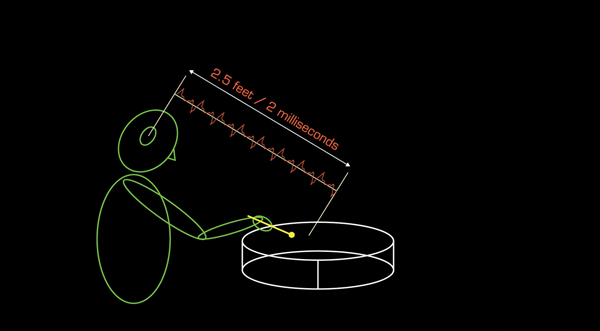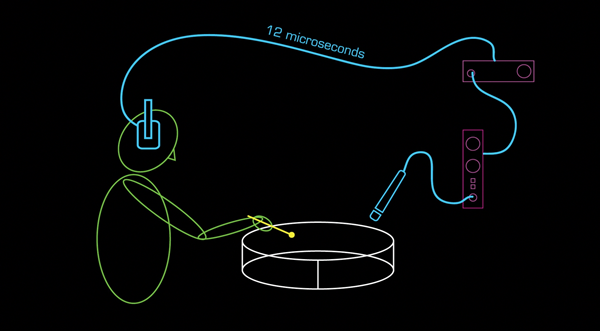Sound wave theory 08
Speed of sound
- Video
- Script
Welcome to this tutorial on the speed of sound.
It is useful for us to understand how sound travels through different mediums such as the air and solid objects like walls. For example, we may wish to estimate the differing phase relationships between microphones placed at different distances from a source, or the effectiveness of sound proofing materials.
Caption - How the speed of sound varies
Sound waves travels at different speeds through gases, liquids and solids. This is because their molecules are spaced differently. For example, air molecules are much further apart than the tightly compacted molecules of steel. The closer the molecules are, the less distance they have to travel, or vibrate, to transmit energy to one another, and the faster the sound wave can travel.
Caption - Speed of sound in air
Sound travels relatively slowly through air at around 340 metres per second, which is equivalent to approximately 1 foot per millisecond.
Although not important for sound recording purposes, it should also be understood that the speed of sound is affected by altitude and temperature.
Caption - Speed of sound through solid objects
Sound travels much faster through a solid object. Through steel it travels at 5,100 metres per second.
It is important to understand that whilst sound travels faster through solid objects, its energy is absorbed faster than in a gas or liquid. It will therefore be either partially or completely absorbed. The amount of absorption depends on the nature and size of the object and the frequency of the soundwave.
Caption - Speed of electrical and digital soundwaves
Once converted into an analogue electrical, digital electrical , or optical signal, sound travels much faster. The speed of an electrical soundwave signal is approximately 200,000 kilometres per second.
It is therefore possible to accelerate the speed with which a soundwave is transmitted from one location to another.
Lets consider the example of a drummer recording in a studio. Assuming their ears are approximately 2 and a half feet from their snare drum, sound will take approximately 2 milliseconds to reach their ears.

But if the drum is close mic'd, and the drummer is using headphone to monitor the sound from the mic via a microphone pre-amplifier and headphone amplifier, the sound will be heard much sooner, with a delay of only 12 microseconds.

Caption - Relationship between frequency, wavelength and speed of sound
Some simple equations relate the speed of sound to frequency and wavelength ...
c = w x f (Speed of sound = wavelength x frequency)
f = c / l (Frequency = speed of sound / wavelength)
w = c / f (Wavelength = speed of sound / frequency)
Key: Speed (c), Frequency (f), Wavelength (w)
Caption - Thanks for watching
The script for this video, with accompanying images, can be found at projectstudiohandbook.com
We suggest you subscribe at our YouTube channel, and join our mailing list at our website to receive notification of new videos, blog posts and subscriber only extras.
Thanks for watching.